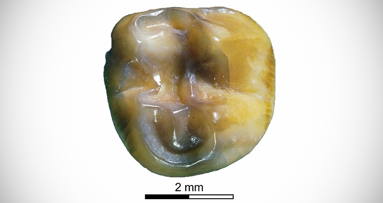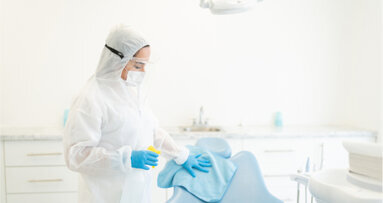CAMBRIDGE, Mass., US: Recent research has offered a new understanding of dinosaurs’ feeding behaviour by means of their tooth wear. Predatory, bird-like theropod dinosaurs from the Upper Cretaceous (100.5–66 million years ago) of Spain and Canada all relied on a puncture-and-pull bite strategy to kill their prey. However, close examination of patterns of wear and modelling of their teeth suggest that these dinosaurs were not necessarily in direct competition for their next meal. Apparently, some of the dinosaurs preyed on larger, struggling prey, while others stuck to softer or smaller fare.
“All these dinosaurs were living at the same time and place, so it is important to know if they were competing for food resources or if they were aiming for different prey,” said lead author Dr Angelica Torices, former postdoctoral fellow at the University of Alberta in Edmonton in Canada and current staff member of the University of La Rioja in Logroño in Spain.
Torices and her colleagues examined the microwear on the teeth to see whether any pattern could be established in the manner of eating of the various dinosaurs. Furthermore, the researchers used a modelling approach called finite element analysis to explore the effects of the dinosaurs’ teeth at different cutting angles.
Both approaches led to the same general conclusion. All of the dinosaurs studied employed a puncture-and-pull feeding movement, in which parallel scratches formed while they bit down into prey, followed by oblique scratches as the head was pulled backwards with closed jaws. However, the researchers reported that the different tooth shapes performed differently under a variety of simulated biting angles.
The evidence suggests that Dromaeosaurus and Saurornitholestes were well adapted for handling struggling prey or for processing bone as part of their diet. By comparison, Troodon teeth were more likely to fail at awkward bite angles. The findings suggest that troodontids may have preferred softer prey such as invertebrates, smaller prey that required a less powerful bite, or immobile prey such as carrion.
The study, titled “Puncture-and-pull biomechanics in the teeth of predatory coelurosaurian dinosaurs”, was published in Current Biology on 7 May 2018. The study was conducted in collaboration with researchers from the Royal Ontario Museum in Toronto in Canada, the University of Alberta and the University of Zaragoza in Spain.
Tags:
BRISTOL, UK: The importance of mother’s milk to an infant’s development is now well established. In a recent study, researchers analysed the fossilised ...
BERLIN, Germany: Imaging techniques based on neutron beams are rapidly developing and have become versatile non-destructive analysing tools in many fields ...
TAIPEI, Taiwan: Conventional periodontal therapies, while effective to a degree, often fall short of fully restoring the complex architecture and function ...
UPPSALA, Sweden: Kangaroos are icons of Australia’s unique living fauna whose earliest ancestry has yet to be discovered. However, using archaeological ...
PITTSBURGH, U.S.: Between 2015 and 2018, the opioid epidemic in the U.S. cost the economy $631 billion, according to a report released by the Society of ...
STOCKHOLM, Sweden: Chewing gum has long been something that many people use. In a recent discovery in Scandinavia, researchers have found that the first ...
In a free Swiss Dental Academy webinar on Thursday, Feb. 27, host Melissa Obrotka will be providing educational insights on the stages of Guided Biofilm ...
CHICAGO, U.S.: Hydroxyapatite is an important component of hard tissue. Tooth enamel, for example, has the highest concentration of the mineral. Since ...
DURHAM, N.C., U.S.: In a recent study, researchers from Duke University in Durham have found that the walking speed of 45-year-olds can reveal a ...
CHAMPIONSGATE, Fla., U.S.: In the interest of public health, the International Academy of Oral Medicine and Toxicology (IAOMT) has published a new research ...
Live webinar
Wed. 14 January 2026
12:00 pm EST (New York)
Dr. Théo Laplane, Dr. Robert Gottlander DDS
Live webinar
Fri. 16 January 2026
12:00 pm EST (New York)
Live webinar
Mon. 19 January 2026
1:00 pm EST (New York)
Philipp Kopp, Michael Seeber
Live webinar
Thu. 22 January 2026
9:00 am EST (New York)
Prof. Judith Jones D.D.S; M.P.H., Prof. Kakuhiro Fukai D.D.S., Ph.D, Dr. Bathsheba (Bethy) Turton
Live webinar
Thu. 22 January 2026
2:00 pm EST (New York)
Dr. Nicola M. Grande DDS, PhD
Live webinar
Wed. 28 January 2026
8:00 am EST (New York)
Live webinar
Wed. 28 January 2026
11:00 am EST (New York)
Prof. Dr. Jan-Frederik Güth



 Austria / Österreich
Austria / Österreich
 Bosnia and Herzegovina / Босна и Херцеговина
Bosnia and Herzegovina / Босна и Херцеговина
 Bulgaria / България
Bulgaria / България
 Croatia / Hrvatska
Croatia / Hrvatska
 Czech Republic & Slovakia / Česká republika & Slovensko
Czech Republic & Slovakia / Česká republika & Slovensko
 France / France
France / France
 Germany / Deutschland
Germany / Deutschland
 Greece / ΕΛΛΑΔΑ
Greece / ΕΛΛΑΔΑ
 Hungary / Hungary
Hungary / Hungary
 Italy / Italia
Italy / Italia
 Netherlands / Nederland
Netherlands / Nederland
 Nordic / Nordic
Nordic / Nordic
 Poland / Polska
Poland / Polska
 Portugal / Portugal
Portugal / Portugal
 Romania & Moldova / România & Moldova
Romania & Moldova / România & Moldova
 Slovenia / Slovenija
Slovenia / Slovenija
 Serbia & Montenegro / Србија и Црна Гора
Serbia & Montenegro / Србија и Црна Гора
 Spain / España
Spain / España
 Switzerland / Schweiz
Switzerland / Schweiz
 Turkey / Türkiye
Turkey / Türkiye
 UK & Ireland / UK & Ireland
UK & Ireland / UK & Ireland
 Brazil / Brasil
Brazil / Brasil
 Canada / Canada
Canada / Canada
 Latin America / Latinoamérica
Latin America / Latinoamérica
 USA / USA
USA / USA
 China / 中国
China / 中国
 India / भारत गणराज्य
India / भारत गणराज्य
 Pakistan / Pākistān
Pakistan / Pākistān
 Vietnam / Việt Nam
Vietnam / Việt Nam
 ASEAN / ASEAN
ASEAN / ASEAN
 Israel / מְדִינַת יִשְׂרָאֵל
Israel / מְדִינַת יִשְׂרָאֵל
 Algeria, Morocco & Tunisia / الجزائر والمغرب وتونس
Algeria, Morocco & Tunisia / الجزائر والمغرب وتونس
 Middle East / Middle East
Middle East / Middle East
















































To post a reply please login or register